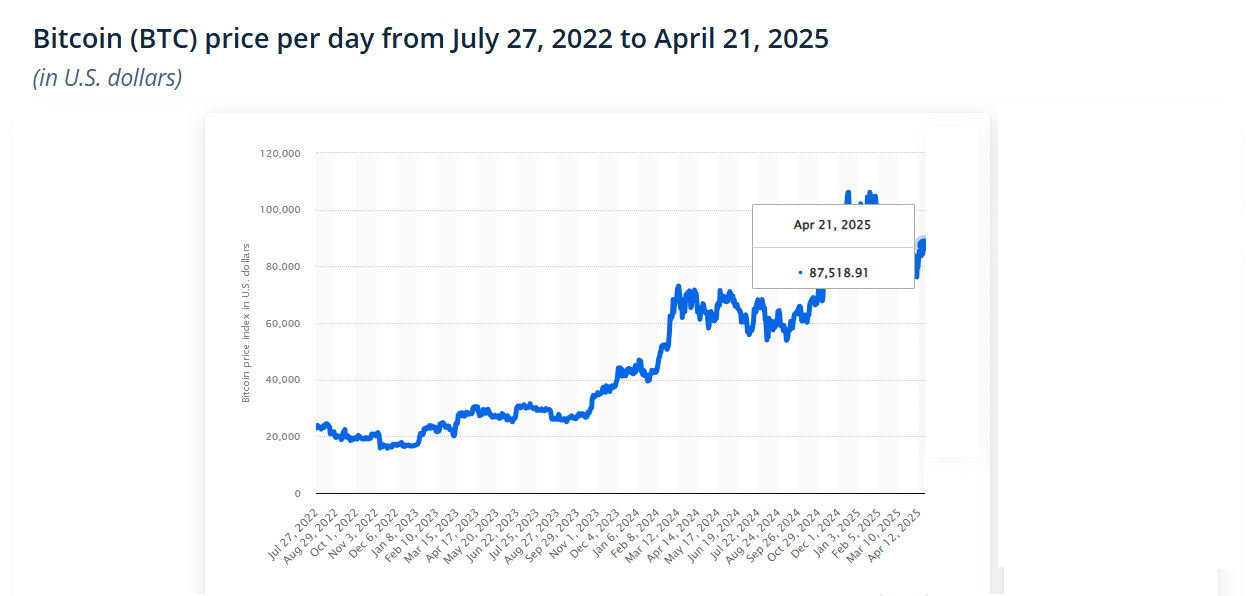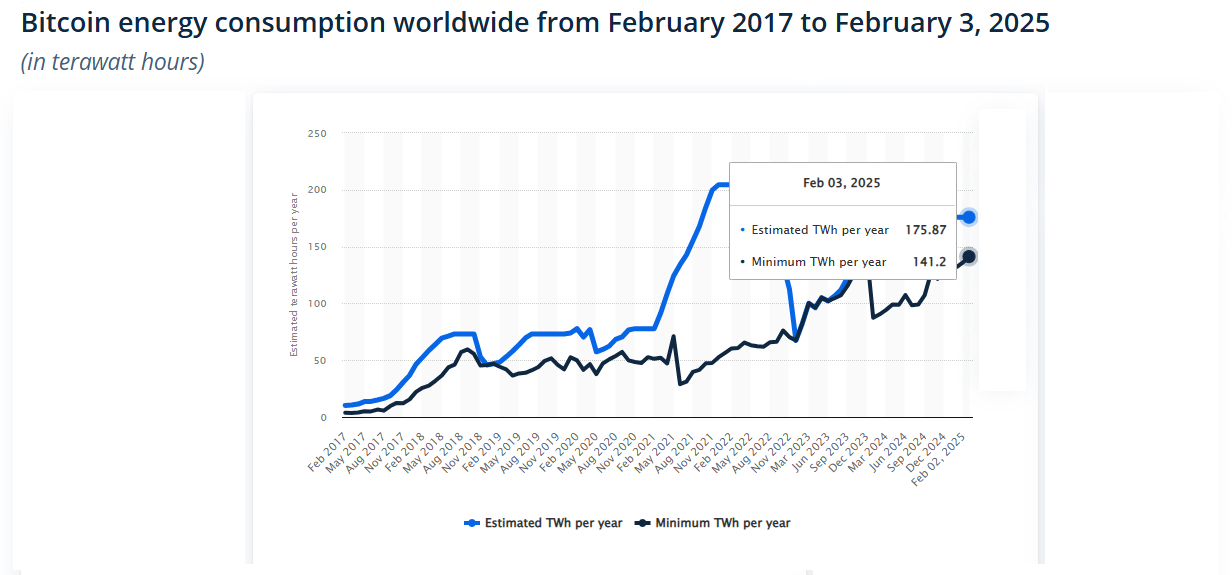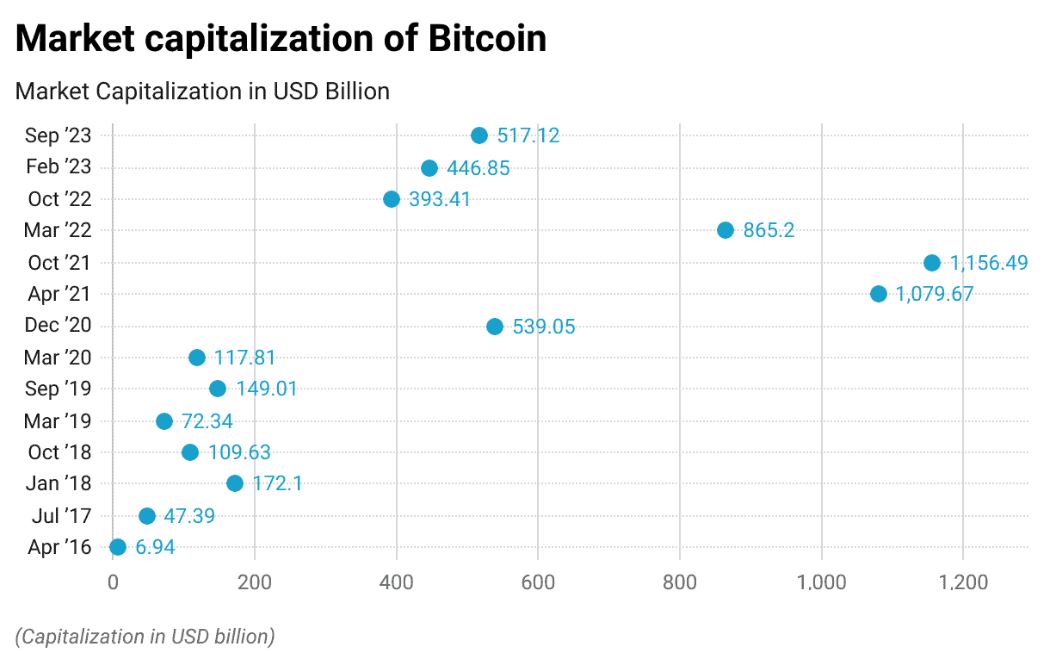Bitcoin Statistics By Market, Demographics And Trends (2025)
Updated · Apr 23, 2025

Table of Contents
Introduction
Bitcoin Statistics: In 2024, Bitcoin experienced significant milestones, reaching an all-time high of USD 108,268 on December 17, 2024, before closing the month at USD 93,429. This surge was influenced by the U.S. presidential election, where President-elect Donald Trump pledged to integrate cryptocurrencies into mainstream financial systems and establish a strategic Bitcoin reserve. The year also saw the approval of Bitcoin spot ETFS, with major financial institutions like BlackRock and Fidelity launching these products, contributing to increased institutional investment.
Notably, over 70% of institutional investors indicated plans to invest in digital assets in 2024. Additionally, Bitcoin underwent its fourth halving in April 2024, reducing the block subsidy from 6.25 BTC to 3.125 BTC per block, which significantly impacted miners’ revenue. Despite these challenges, Bitcoin’s price has increased by 33% since the halving, demonstrating resilience and growing adoption in the financial sector.
The article summarises Bitcoin statistics and trends that are earmarked to give enthusiasts and traders a quick overview.
Editor’s Choice
- Bitcoins reached the price of US$73,000 in March 2024, an all-time high, following the approval of Bitcoin ETFS in the U.S., which was a major inflow from the approval.
- Bitcoin statistics show that after the FTX collapse and other setbacks in trading, the price of one Bitcoin was about US$85,063.41 by April 19, 2025.
- Out of a total maximum supply of coins of 21 million Bitcoin, 89% were mined by April 2021, and full supply is likely to be reached by 2040.
- A very small number of Bitcoin whales (2%) could control up to 92% of free-market BTC, rendering it highly sensitive to movements.
- Ethereum is roughly 30 times cheaper than Bitcoin, revealing a wide pricing gap between the top two crypto assets.
- Bitcoin’s size of blockchain size almost reached 5,450 GB in 2024, with the addition of about 1 GB every other day.
- The capitalisation of Bitcoin was highly volatile, topping US$1.15 trillion in October 2021, yet falling to US$446.85 billion in February 2023.
- Bitcoin statistics indicate that the daily trading volume changes were major: US$0.3 billion in 2017; US$71.7 billion in January 2021; US$32.5 billion in October 2023.
- 25-34 {38.2%} is the age group of the most active bitcoin users in Europe; 35-44 {25.5%} comes second.
- According to Bitcoin statistics, 86.9% of Bitcoin users are male and 13.1% are female, creating a deep gender gap.
- By 2025, about 55% of people in the U.S. aged 18-34 are expected to invest in Bitcoin.
Key Facts
- The Bitcoin market became very volatile after the late 2024 U.S. election results, with BTC even crossing the US$100,000 line several times.
- From its fully decentralised form, this digital asset is gradually leaning towards the norms of institutions and investor behaviour.
- It is investor optimism of having new government regulations on crypto that was one important surge-pusher of price changes.
- In 2025, the price of bitcoin fell again to US$100,000 after a new artificial intelligence model, DeepSeek, had been proclaimed to outperform others greatly.
- January 2025 experienced a sharper price decline: it fell below US$90,000 due to critical new macroeconomic data from the U.S.
- Such patterns confirm that Bitcoin is becoming increasingly sensitive to external sentiment, thus behaving like conventional stocks.
- The 2025 vision for Bitcoin looks very different from the previous one–2024–having increasingly favourable support from the White House and probably rising corporate holdings in Bitcoin as an inflation hedge.
- More and more institutional investors are heading towards Bitcoin, and it is also being thought that governments might include it in their official reserves of currency.
- The biggest issue remains that of defining a use case strong enough to create success for Bitcoin. Even though it is highly popular as an investment, it is still not hugely popular as a transactional medium in day-to-day life in many countries.
- Bitcoin statistics show that Bitcoin usage in any particular country is proving to be very hard to come by due to the anonymous and decentralised nature of the network.
- One method for estimating Bitcoin usage by country is to observe the trading volumes of Bitcoins with local currencies; however, this has its limitations and shortcomings.
- Bitcoin transactions are designed such that it becomes difficult to trace them back to the point of origin, thus leaving scarce, reliable geographic data.
- Insights are mostly drawn from surveys asking people if they own or use Bitcoin; these generally show that ownership tends to be higher among populations outside the U.S. and Europe.
- Emerging markets, according to Statista’s Global Consumer Survey, will be more inclined to certain forms of crypto assets.
- Bitcoin already made its mark on front-page news in 2025, showing how important it would be to future financial discussions during the coming months.
Bitcoin BTC/USD Price History Up

(Source: statista.com)
- According to Bitcoin statistics, in 2024, Bitcoin (BTC) rose to an all-time high of more than US$73,000 in March, largely due to the acceptance of Bitcoin ETFS in the US.
- Contrast this with the previous year. Unlike 2021 price surges, which were the result of events involving companies like Tesla and Coinbase, for instance: Tesla purchased US$1.5 billion worth of bitcoins, announced it in March 2021; launched an initial public offering for Coinbase, the largest U.S. cryptocurrency exchange.
- Unfortunately, all that changed by the end of the year was the chaotic thermals. The Bitcoin prices forged well back at US$85,063.41 by April 19, 2025. Unlike any traditional currency, like the dollar, whose central banks can easily print to infinity, the maximum supply of Bitcoin was hard-coded into it.
- As early as April 2021, almost 89% of the total supply had been mined; by all indications, Bitcoin will reach maximum supply around 2040, even though mining technology is advancing.
- This is because every four years, the level of the mining process difficulty is modified significantly as part of its built-in halving process.
- Thus, a simple Bitcoin transaction could consume energy equivalent to that of small countries in 2021. Predicting the future price of Bitcoin is difficult because of limited traditional financial metrics and the unique structure of the market.
- Bitcoin statistics reveal that, reportedly accounting for only around 2% of all anonymous Bitcoin accounts, these whales enjoy their estimated holding of 92% of the available BTC.
- Furthermore, most users of cryptocurrency in the world are retail investors compared to big institutions. Hence, a minute move by any major holder will create ripples across the market, rendering long-term price forecasts uncertain.
Price Development Of The Top 100 Cryptocurrencies
| Characteristic | Price (in U.S. dollars) | 24h price change | 7d price change |
30d price change
|
| Bitcoin (BTC) |
$80,993.00 | -1.30% | -2.50% | -0.60% |
| Ethereum (ETH) |
$1,548.59 | -4.20% | -14% | -17.60% |
| Tether (USDT) |
$1 | 0% | 0% | 0% |
| Ripple (XRP) |
$2 | -0.30% | -2.90% | -7.80% |
| Binance Coin (BNB) |
$580.36 | 0.20% | -2.40% | 5% |
| Solana (SOL) |
$116.49 | 0.30% | 0.30% | -4.40% |
| USD Coin (USDC) |
$1 | 0% | 0% | 0% |
| Dogecoin (DOGE) |
$0.16 | -0.80% | -4.50% | -3.60% |
| Cardano (ADA) |
$0.63 | 0.50% | -3.60% | -12.80% |
(Source: statista.com)
- However, as far as being one of the most expensive cryptocurrencies went, as of April 2022, the prices had still continued to show fluctuations.
- Although it once held the title of being the most valuable digital currency at a time, Ethereum came much cheaper, trading nearly 30 times less than Bitcoin.
- As a result, Bitcoin has a rather unique position in comparison to other coins in the market.
- For instance, unlike Ethereum, which belongs to a blockchain that is constructed to aid in financial applications and create smart contracts, Bitcoin is often known to be the digital form of gold.
- Distinguishing it from a majority in that its purpose is to serve as a store of value above many other cryptocurrencies that can either perform practical functions or serve as platforms for decentralised finance applications, Bitcoin will mainly be held for its purchasing power and future value.
- It does not serve very well as a means to conduct fast or frequent transactions since it’s slow, and it does not really have an infrastructure to support far broader financial functionalities.
- Many cryptocurrencies gained ground, including some with price stabilisation property, referred to as stablecoins. Almost typically pegged to the value of an external asset like the U.S. dollar, these coins have limited price fluctuations, as do ordinary cryptocurrencies.
- More and more of this kind form a part of the whole crypto market now. While some consider stablecoins as providing an answer to the future of everyday retail payments because of their predictability, others believe they are a good element to include in a larger crypto investment strategy.
Bitcoin (BTC) Blockchain Size

(Source: statista.com)
- Bitcoin statistics show that with the ongoing deposit of transaction data, the blockchain of Bitcoin has grown to almost 5,450 GB by the year 2024, which keeps adding up by about a GB every few days.
- The main features of the growing database include offering a detailed, irreversible history of all Bitcoin transactions from its inception in January 2009, with complete transparency.
- Bitcoin was designed to reduce the supply gradually, with the final coin being mined around the year 2140, according to 2017 estimations on mining forecasts. This has so far led to widespread interest in Bitcoin mining, although scant reliable information exists about mining activities in different regions.
- The almost total lack of transparency is inherent in the basic philosophy behind the formation of Bitcoin, to protect privacy and prohibit centralised control.
- The nature of mining transactions is designed into the blockchain, thus hiding both the country of origin and the destination country.
- An IP-address-based study of Bitcoin mining activity identified the United States as the number one country for mining Bitcoin in 2022.
- However, the results remain inconclusive since IP addresses can be masked by various services such as VPNs. That said, distinguishing mining activity from trading behaviour, Africa and Latin America exhibit higher levels of engagement in buying and selling Bitcoin than in many developed nations.
- In trading volume activity, Bitcoin’s trading volumes fell during Q2 of 2023, where they had seen huge increases at the beginning of the year.
- Despite that drop, in the second half of June 2023, Bitcoin outperformed a majority of the crypto market, largely due to the filing for a Bitcoin ETF by BlackRock under the iShares brand and with Coinbase Custody as the custodian. This meant that up until that point, U.S. regulators had not approved any apps for a spot Bitcoin ETF; nothing was set in stone.
Global Bitcoin (BTC) Energy Consumption

(Source: statista.com)
- In early 2022, when Bitcoin had an all-time high annual electricity consumption, estimates suggest that its consumption actually exceeded that of the entire Finland.
- These estimates stem from the sources which attempt to calculate Bitcoin’s energy consumption on the premise that miners reinvest their income in more powerful hardware. In this model, the more miners make, the more energy they are expected to consume.
- Bitcoin statistics show that in 2025, Bitcoin was expected to have an energy target between that of Australia and the Netherlands. Due to the decentralised nature of Bitcoin mining, there is no repository or authority where miners register their actual energy consumption.
- As Bitcoin nears its hard cap of 21 million coins, mining becomes harder and more resource- intensive. This is a trait unique among cryptocurrencies, so not all have capped supplies.
- With over 90% of all Bitcoin already mined, new coins require exponentially more computational power to generate and thus also affects the blockchain’s overall growth.
- At any rate, the growth trend is slowing down relative to prior years.
- Estimates available indicate that with the rise in mining hashrate, the United States has taken the upper hand from China in Bitcoin mining.
- The costs of electricity play another vital role in determining where to set up the mining operations, with the general trend that locations offering cheaper power would be more appealing to the miners.
Bitcoin Market Capitalisation

(Source: scoop.market.us)
- Bitcoin was traded with a huge market capitalisation. From US$6.94 billion in April 2016, the market cap was a modest one, but then came July 2017 when its market capitalisation shot up to US$47.39 billion.
- According to Bitcoin statistics, in a few months, Bitcoin drew more attention in January 2018 with a market cap of US$172.1 billion. But this value did not settle long and fell to US$109.63 billion by the end of October. Such price fluctuations persisted as the market capitalisation increased to US$149.01 billion in September 2019, only to sink again to US$117.81 billion by March 2020.
- But by late 2020, there was a much-steered market regain, with market capitalisation increasing to US$539.05 billion in December.
- In this regard, it’s significant for 2021 since, in April, the market capitalisation of Bitcoin crossed the US$1 trillion line to settle at US$1,079.67 billion, later rising to US$1,156.49 billion by October. While this number constitutes a period of great decline, the same fell to US$865.2 billion by March 2022, clearly illustrating the volatility of the asset’s worth.
- Bitcoin’s market capitalisation estimates are US$446.85 billion as of February 2023.
- With no signs of the cryptocurrency market stabilising, the fluctuations therefore reinforce Bitcoin’s relevance as an emerging and dynamic factor in the crypto industry.
Bitcoin Trading Volume
- Bitcoin’s daily trading volume is on wild fluctuations over time, hinting at the entrance of the usual dynamics of the cryptocurrency market.
- Bitcoin statistics reveal that on March 27, 2017, the trading volume was somewhat low, at US$0.3 billion, suggesting that this time was less than the early days of the market.
- On January 29, 2018, volume was quite high, with US$8.6 billion, indicating a lot of interest.
- In August of 2018, it maintained at an impressive level of US$4.2 billion, reflecting consistent market interest.
- The volume grew to US$5.6 billion on January 28, 2019, and then increased far more to US$14.9 billion on August 26, 2019, suggesting a surge in trading.
- A bounce of US$45.2 billion in daily trading volume on April 27, 2020, constituted another giant leap in the trading history of Bitcoin.
- On October 26, 2020, US$31.2 billion in volume proved quite high, indicating steady buying interests. This peaked yet again on January 25, 2021, when the trading volume marked a considerable US$71.7 billion in the global finance market focus on Bitcoin.
- However, by July 26, 2021, it had fallen to US$33.4 billion. On January 31, 2022, the value further shrank to 20.7 billion U.S. dollars, after which it recovered slightly and reached 29.8 billion dollars on August 29, 2022.
- On January 30, 2023, the daily trading volume for Bitcoin was found to be US$24.7 billion.
- A more recent instance occurred on October 23, 2023, with daily trading volume set at US$32.5 billion, which reflects the continued interest and activity of the Bitcoin market.
Bitcoin Demographics
- An investigation into the European Bitcoin user presents a wide spread concerning the individual’s age group, which manifests in the willingness to fulfil the cryptocurrency requirement.
- Bitcoin statistics show that the biggest market segment is available from 25 to 34 years of age, accounting for 38.2% of Bitcoin users.
- Closely following is the age group of 35 to 44 years at 25.5%, which shows impressive participation among middle-aged individuals.
- Users aged between 18 and 24 years represent 15.3% of the total Bitcoin population, while the age group of 45 to 54 years accounts for 13.1%.
- They come in next as those aged between 55 and 64 years, making up 5.6%, while the total of the smaller 65+ portion is 2.3% of the user base.
- Around 55% of all people between 18 and 34 in the United States are expected to buy Bitcoin by 2025; the youngest generations are getting more and more interested in the cryptocurrency as a result. This slice of age demographics illustrates how “sweepingly adopted” Bitcoin already is: from young to old, it will easily be adopted by all generations.
- In gender terms, therefore, there has been a palpable underuse of Bitcoin. Only around 16% of men and 7% of women claim to use cryptocurrencies, but within the Bitcoin user community, men far outpace women: 86.9% of the total are men.
- Women represent just 13.1%, highlighting the gender gap. There must be some awareness and hence action to increase inclusivity and encourage participation and involvement from all genders in using Bitcoin.
- This has become an important pen-discourse toward the Bitcoin community and the larger stakeholders in the cryptocurrency ecosystem.
Recent Trends
- The Bitcoin Network Hash Rate is the overall computing power associated with it and has experienced very high fluctuations for the observed period.
- According to Bitcoin statistics, on October 3, 2022, the hash rate was 238.84 exahashes per second (EH/s). By January 28, 2023, it had risen significantly to 298.0074 EH/s, suggesting a growing strength in the network. This upward trend continued, reaching 318.23 EH/s by April 1, 2023. Further expansion was evident on May 2, 2023, when the hash rate climbed to 362.87 EH/s, reflecting the increasing scale of mining activity.
- A slight dip occurred on June 4, 2023, reducing it further to 339.96 EH/s, which was then corrected a few hours later by a rise on July 11, 2023, to 379.22 EH/s.
- Continuous activity remained strong, with the rate hitting 419.33 EH/s on August 21, 2023. As of September 26, 2023, the hash rate is slightly down to 392.33 EH/s.
- However, this upside trend soon picked up fast, and by October 26, 2023, it was at a new high of 486.49 EH/s.
- These fluctuations landscape the dynamic nature of Bitcoin computational resources and highlight the ever-increasing competition among miners to maintain and secure the blockchain network.
Conclusion
The year 2024 proved to be very important for Bitcoin, bringing record-breaking prices, solid hashrate growth, and increasing institutional engagement. All these events have signified the changing role of Bitcoin in the global financial landscape. The cryptocurrency is getting mature, so stakeholders need to brace themselves for future challenges and opportunities.
FAQ.
Bitcoin breached the US$100,000 mark several times in 2024, fueled by investor optimism boosted by the U.S. elections, and an expectation of crypto-friendly regulations. But, in early 2025, it fell under US$100,000-and later under US$90,000-followed by an outward effect from new AI model accomplishments such as DeepSeek and unfavourable macro U.S. data. Fluctuations in price convert Bitcoin into becoming increasingly sensitive to global economic sentiment.
Bitcoin touched the peak price of US$73,000 in March 2024, mainly due to the approval of Bitcoin ETFs in the USA. This again rekindled the interest of institutional players; thus, the price soared. Peaks observed before 2021 were fueled by events like the purchases of Bitcoin by Tesla and the IPO of Coinbase.
As of 2021, nearly 89% of Bitcoins in existence (21 million coins) had been mined. Due to the halving mechanism reducing mining rewards every four years, it will be around the year 2140 that the last Bitcoin is expected to be mined.
Bitcoin’s most active users belong to the age groups of 25-34 and 35-44, accounting for 38.2% and 25.5% respectively. There is a significant gender disparity: 13.1% of users are female, while 86.9% are male. This suggests an increasing requirement for inclusivity and awareness within the cryptocurrency ecosystem.
Bitcoin mining, in fact, consumes as much energy as would be utilised by whole countries like Australia or the Netherlands by 2025. Mining activity is difficult to verify because of anonymity and decentralised operations. However, the U.S. is now taking over China in the estimated hashrate by 2022. Lower electricity prices generally drive an increase in mining activity in particular regions.

Joseph D'Souza founded ElectroIQ in 2010 as a personal project to share his insights and experiences with tech gadgets. Over time, it has grown into a well-regarded tech blog, known for its in-depth technology trends, smartphone reviews and app-related statistics.










